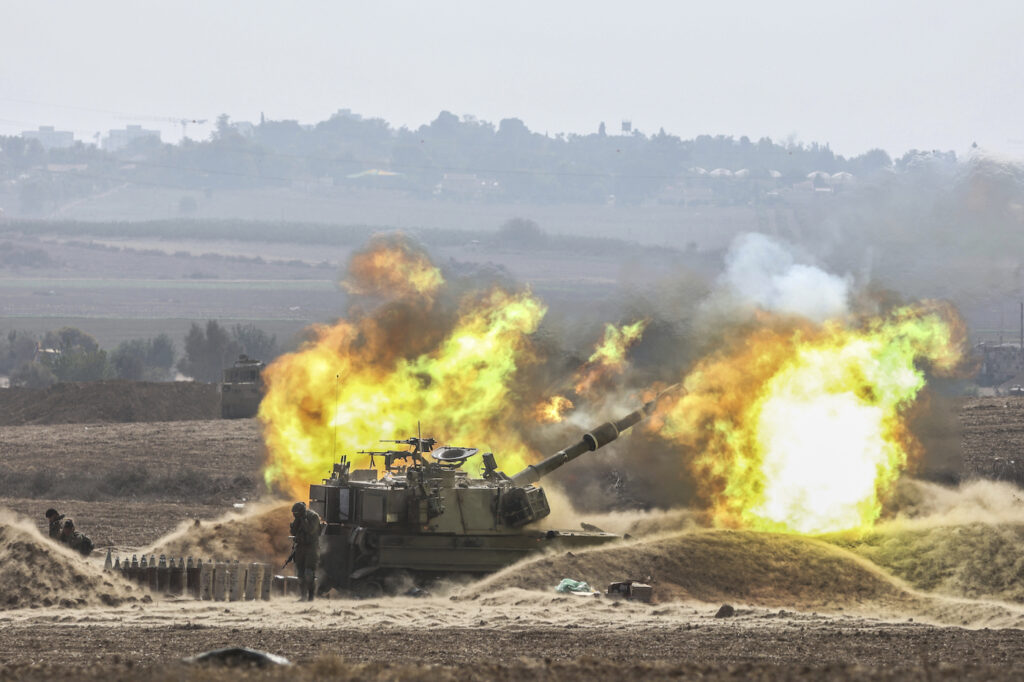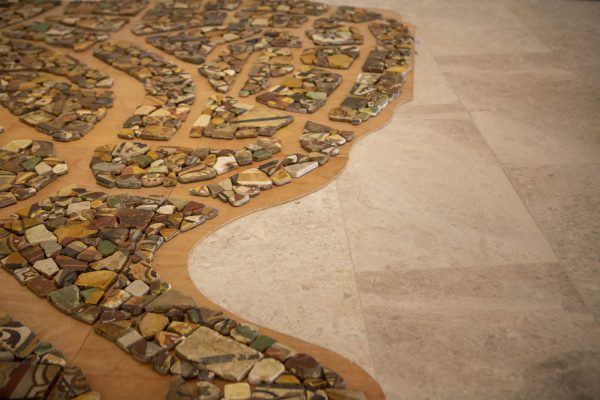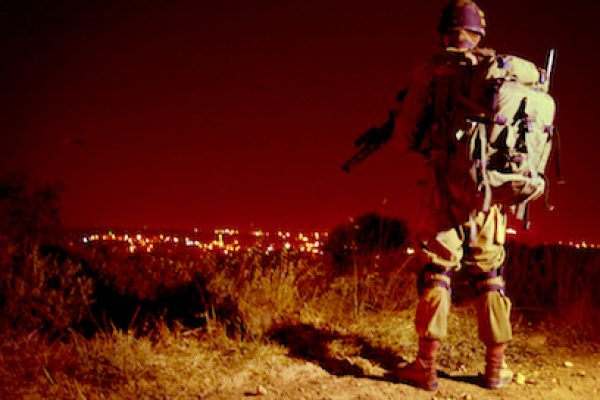Last Saturday Hamas, the Islamic Resistance Movement that has governed Gaza since being elected in 2006, carried out an unprecedented attack on Israel. It struck almost fifty years to the day after a surprise attack by Egypt and Syria against Israel, which has not experienced an assault on this scale within its borders since it was founded in 1948.
Precise details of the attack are still being reported, but the basic elements are worth reviewing. In a matter of hours, Hamas’s military wing, the Izz al-Din al-Qassam Brigades, carried out a multifaceted operation. It launched a barrage of 5,000 rockets into Israel, breaching part of Israel’s Iron Dome, among the world’s most advanced missile defense systems. It broke through the Gaza border fence after using drones to disable the electronic surveillance system, crossed into Israeli territory using motorbikes, trucks, dune buggies, and even paragliders, and overran three Israeli military bases, at Zikim, Re’im, and the Erez border crossing. It captured significant equipment, including armored vehicles, and transported at least some of it back to Gaza. It killed at least 169 soldiers, including 23 officers, and captured many others. And it seized numerous hostages (both civilian and military), killed hundreds of civilians, and wounded thousands. As of today, the official Israeli estimate is that 1,200 people, including children, had been killed and 3,418 injured. Another 150, civilians and soldiers, have been kidnapped. Hamas’s attack was widely condemned, including by the United States, which, like Israel and the United Kingdom, deems Hamas a terrorist organization.
Retaliatory airstrikes on Gaza, which Israel has blockaded by land, sea, and air since Hamas rose to power in what the UN and human rights organizations decry as an “open-air prison” and a contravention of international law, have already killed 490 Palestinian civilians—the worst bombings the territory has suffered in fifteen years. Within a day Israeli warplanes and missiles had struck 500 sites. Building up troops at the border, Prime Minister Benjamin Netanyahu has vowed to “destroy Hamas’s capabilities” and warned Gaza’s residents to “get out now . . . we will be everywhere and with all our might.” In reality, there is nowhere for the more than 2 million people in Gaza, which is about a tenth the size of Rhode Island, to go. Beyond that, Gazan civilians will suffer from Israel’s decision to tighten the blockade by cutting off supplies of water, food, gas, and electricity in what Defense Minister Yoav Gallant has called “a complete siege.”
In the short term, tit-for-tat strikes are likely to continue, with civilians in Gaza, especially Gaza City, getting the worst of it. Inside Israel, Netanyahu’s government will face scrutiny for being blindsided by such a massive assault, along with serious political pressure to deliver punishing retribution, not unlike the response to 9/11 within the United States. Amid the ongoing reporting and moral condemnations, we need clear historical context for this latest eruption of fighting between Hamas and Israel—and what it portends for the future.
Hamas’s military forces are named for Izz al-Din al-Qassam, a cleric and Arab nationalist born in Jableh, Syria, in 1882. The link is important. Following the defeat and dissolution of the Ottoman Empire after World War I, the newly established League of Nations assigned Palestine to Britain in 1922 as a “mandate,” pending the determination of its permanent status. Qassam saw this move as nothing more than colonialism. Even more galling to him was the British decision, over which Palestinians had no say, to open the region to immigration by Jews. Such immigration had begun in the 1880s, inspired by the Zionist movement’s mission to create a Jewish homeland—an enterprise Britain committed to supporting in the 1917 Balfour Declaration—but it significantly increased in the 1920s and ’30s. In 1922, 11 percent of the population of Palestine was Jewish, versus 3 percent at the end of the nineteenth century; by 1944 it had increased to 30 percent, and the immigration was an important factor in the 1936–1939 Arab rebellion. Qassam also opposed European domination elsewhere in the Middle East, whether Britain’s control of Egypt, Italy’s colonization of Libya, or French rule in Syria, which was enabled by another League of Nations mandate. He died in 1935 battling British troops, having earlier fought the French in Syria.
Founded in 1987, when the first Palestinian intifada began, Hamas shares Qassam’s characterization of Zionism as British-backed settler colonialism and the Palestinian Arabs as the original and rightful inhabitants all of the land between the Mediterranean Sea and the Jordan River. Rejecting the 1947 UN partition plan for Palestine as tantamount to theft, it holds that the Israeli state itself is illegitimate and must be eradicated. In these respects, Hamas differs from the other major Palestinian party, Fatah, led by Mahmoud Abbas and based in the West Bank, which has been occupied by Israel since the 1967 Six-Day War. (Gaza was formally occupied then as well; it was not until 2005 that Israel withdrew soldiers and Jewish settlements.) Though initially committed to armed resistance, Fatah was eventually prepared to recognize Israel and negotiate with it in hopes of establishing a Palestinian state—the so-called two-state solution, which was pursued, though unsuccessfully, during the Oslo negotiations of the 1990s. Hamas and Fatah have had a contentious relationship, which has at times turned violent.
It bears noting, however, that the UN partition is regarded as an injustice even by Palestinians who have nothing to do with Hamas. The signal event that followed from the partition and that has been seared into Palestinians’ memory is the forced expulsion or flight of 700,000 of their forbears from the territory the UN assigned to Israel, the killing of another 15,000, and the destruction of at least 400 villages—what Palestinians call the Nakba (Arabic for “catastrophe”). Many of those displaced in these years ended up in Gaza.
It is also revealing that Hamas has dubbed the October 7 assault “Operation Al-Aqsa Flood,” linking the attack with the Al-Aqsa Mosque in East Jerusalem. The mosque’s compound includes the Dome of the Rock shrine, built on what to Jews is the Temple Mount and to Muslims the Haram al-Sharif, the site from which they believe the Prophet Muhammad ascended to heaven.
For Jews, particularly the most pious, the Temple Mount marks the spot where the First and Second Temples stood and the place where many momentous events related in the Old Testament occurred, including God’s test of Abraham’s devotion by directing him to sacrifice his son Isaac. Since taking control of East Jerusalem from Jordan after winning the Six-Day War in 1967, Israel has forbidden Jews from praying at the Temple Mount, as part of an agreement negotiated among Israel, Jordan, and the Muslim trust that administers the Al-Aqsa compound. Jews can and do visit the Temple Mount, but in recent years ultra-Orthodox Jews in particular, committed to building the Fourth Temple, have prayed there, and Israeli authorities have not stopped them.
The question of who rightly owns Jerusalem, which Israel formally declared as its capital in 1980 (and which Donald Trump recognized in 2017, leading to the opening of a U.S. embassy there the following year), has been a central to the dispute between Muslims and the most religious of Israel’s Jews. There’s no doubting Hamas’s position on this matter. It characterized the October 7 attack as a defense of Al-Aqsa against what it claimed have been increasing encroachments—by Jewish worshippers as well as the Israeli security forces who entered the mosque this April after Palestinians barricaded themselves inside it.
This was not the first time the mosque and its environs have triggered violence between Israel and Hamas. In May 2021, after Jewish settlers tried to expel Palestinians from parts of East Jerusalem and Israeli security forces injured hundreds of Palestinian protestors while dispersing them, Hamas and allied groups targeted Israel with more than 4,000 mortars and rockets, killing 12 civilians. Israel responded with retaliatory attacks against hundreds of targets and air strikes that have hit multilevel buildings, including residential ones.
The religious element in the Israeli-Palestinian conflict has become particularly pronounced after the November 2022 Israeli elections, when Netanyahu, leader of the increasingly right-wing Likud party, formed a coalition with the far-right Jewish Power (Otzma Yehudit) and Religious Zionist (HaTzionut HaDatit) parties. Supporters of these two parties believe that the entire West Bank, including Jerusalem, is part of the biblical Greater Israel and hence belongs exclusively to Jews, who are entitled to build settlements on it without restraint.
There has been a dramatic increase in settlement since the 2022 election. According to the Israeli NGO Peace Now, the government “promoted 12,855 housing units” in the West Bank in the first six months of 2023 alone, almost twice as many as it did in the preceding two years combined. In addition, the demolition or seizure of Palestinian homes in East Jerusalem, and attacks by settlers on Palestinians, continues. The UN’s Office for the Coordination of Humanitarian Affairs reports that 752 “Palestinian-owned structures” in the West Bank have been destroyed between January and October of this year, displacing 1,182 people, whereas the corresponding figures for all of 2022 were 954 and 1,032. Violence by West Bank settlers against Palestinians has likewise increased sharply since 2021.
In short, Hamas and the ultra-religious parties that are now part of Israel’s government are defined by irreconcilable historical, religious, and political narratives. These beliefs are hardly new, nor are they sole source of the enmity between Israel and Hamas, or the only explanation for the October 7 attack. Still, it cannot be understood fully without taking them into account. Furthermore, the diminished stature of Fatah in the West Bank, Hamas’s dominance in Gaza, and the powerful role of ultranationalist parties in Israeli politics have together increased the probability of violent confrontations between the IDF and the Al-Qassem Brigades.
As for the future, the plight of Gaza’s more than 2 million people will doubtless polarize the Middle East to an extent not seen in many years, especially if the war continues for weeks or months. The calling up of 300,000 IDF reservists and the massing of 100,000 in southern Israel, confirmed by Israel’s chief military spokesman, suggest that Netanyahu’s government has, at the very least, not ruled out that option.
Then there is the risk of third parties being drawn into the war. Already Israel and Hezbollah, the Lebanon-based Shiite militia, closely aligned with Hamas as well as Iran, have traded rocket and artillery fire, increasing the ambit of violence; and things could get much worse on that front. Iran has given full-throated support to Hamas but has stayed out of the fighting—so far. But that could change if a Wall Street Journal story—supposedly based on information from “senior members of Hamas and Hezbollah”—claiming that Iran’s Islamic Revolutionary Guard Corps helped plan the Hamas attack in the weeks leading up to it proves accurate—or is accepted as such by Israel. There are, however, good reasons to doubt the veracity of the story, including the improbability that a leak as explosive as this should occur now about an operation that was long in the making and kept secret all the while. Moreover, both the American and Israeli governments say they have no evidence pointing to Iran’s involvement. Nevertheless, given the enmity between Iran and Israel, a clash between them, accidental or premeditated, cannot be dismissed out of hand.
The United States has already been pulled into the crisis. At least nine U.S. citizens were among those killed during Hamas’s attacks; Secretary of Defense Lloyd Austin has ordered an aircraft carrier task force to move into the eastern Mediterranean Sea, and President Joe Biden has authorized the flow of military aid to Israel. Though it does not seem probable, if the crisis leads to an armed confrontation between Iran and Israel, U.S. military involvement could deepen and become more direct.
Finally, before Hamas’s attack it seemed that Middle East might be reshaped by a momentous development: the normalization of relations between Israel and Saudi Arabia, prompted among other things by their shared apprehension of Iran. As part of that deal in the making the Saudis sought a security guarantee from the United States plus an U.S.-run uranium enrichment plant. The war between Hamas and Israel will at the very least delay this move, which was hardly a done deal in any event.
Saudi Arabia’s Prime Minister and Crown Prince, Mohammed bin Salman (colloquially known as MBS), the Kingdom’s de facto ruler, can ill afford to be seen cozying up to an Israel that is bombing the Gaza Strip relentlessly and depriving its denizen of even the basics needed for survival, no matter the Saudis’ deep, longstanding opposition to Hamas’s alignment with Iran. As the “Custodian of the Holy Mosques” (in Mecca and Medina), Saudi Arabia’s king has a special status in the Islamic world and Salman knows that the monarch has an image to maintain, particularly on the Arab street. For the same reason, this is not the best time for MBS to make headlines by receiving, or even pushing for, a security guarantee from the United States, which is virtually, albeit not formally, Israel’s ally.
As for New York Times columnist Bret Stephens’s proposal for a combined effort by Israel, Saudi Arabia, and Egypt to end Hamas’s rule in Gaza, with Israel using military force followed by Riyadh and Cairo deploying “a substantial peacekeeping force,” it was a stretch at the best of times, to put it mildly. Now it looks quixotic. MBS may want to get rid of Hamas, and Egyptian president Abdel Fattah el-Sisi may see it as an extension of his nemesis, the Muslim Brotherhood; but both rulers are hard-nosed pragmatists, not throw-caution-to-the-wind types.
The long-term question, raised anew by this latest bout of violence, is whether a political solution to the Palestinian-Israeli dispute can ever be found. The one-state formula—all individuals, regardless of religion, guaranteed equal rights—has little purchase in Israel, even among those who support Palestinian self-determination strongly. Support for Israel as a Jewish state remains strong among Israelis, be they religious or secular, Ashkenazim or Sephardim.
The model of two states living by side—Palestinian having full control over the West Bank and Gaza, with East Jerusalem as the capital—was roughly the goal of the 1990s Oslo negotiations, but it has become much more complicated to accomplish because of what has occurred in the West Bank. Since 1967, 279 Jewish settlements have been established there, and they are now home to 700,000 Israeli Jews. For a territorially continuous and substantial Palestinian state to emerge the settlements would have to be dismantled, and Israel would have to yield East Jerusalem. No Israeli government would want to embark on that politically explosive mission, and so long as religious parties play a role in governing, it won’t be entertained even as an idea. More fundamentally, just as Hamas denies the legitimacy of Israel and rejects a two-state solution, ultra-religious Israeli parties reject the very notion of a Palestinian state, no matter its configuration. Furthermore, the scale and surprise of Hamas’s attack could well embolden and strengthen Israelis who warn that any kind of Palestinian state would pose a mortal threat to their country.
We are, then, left with the dismal and dangerous future featuring intermittent cycles of violence between Israel and Hamas. As always no one will suffer more than civilians—Israelis, but particularly Palestinians living in Gaza. And while this particular confrontation may pass without other states joining the fray, we cannot count on that happening forever.
Still, we have witnessed momentous and unexpected changes in the last twenty-five years—including the end of apartheid in South Africa, the collapse of the Soviet Union, and before that the end of communist rule in Eastern Europe. Changes within Israel and in the world that make for a more hopeful turn of events cannot be ruled out, especially as voices for dialogue and reconciliation exist within Israel and among Palestinians. That, at least, must be our hope.







